Table of Contents
Different Types Of Wisteria and How To Choose
Before we discuss the five most prominent varieties of Wisteria, we’ll first lay out this intriguing plant's history.
The History Of Wisteria
Wisteria began their world travels in Central China, where the woody climbing legume and bright purple flowers were herald for their climbing ability. There are
The long-lived vining plant was first introduced to the United States as a Japanese variety that was introduced around 1830 as an ornamental flowering plant. It then became popular in the southern states as a decorative addition to gazebos and gardens. Wisteria is a hardy plant that can thrive as far north as New England.
Wisterias have long been a symbol of romance, especially in cultures like Korea, where they mean “devotion that exceeds death.” On the other hand, the Japanese hold Wisteria on a pedestal coveted for its symbolism of wealth, longevity, and good luck.
Seed hunters in the 1800s took Wisteria to the west and had to wait up to 20 years to see the first blossom. On average, depending on genetic variation, they took from 8-10 years to see the first blossom. Today gardeners can shock their Wisteria into blossoming by severing the roots to create a stress reaction that kicks off the blooming survival mechanism.
How To Use Wisteria In Your Garden
Wisteria are climbing vine plants with cascading flowers. Aesthetically they make a spectacular pergola or archway with hanging blossoms. In addition, they can be used to climb fences, pergolas, or lattice.
They are fast-growing vines that can also be used on unsightly walls or other architecture to camouflage with colorful coverage.
Types of Wisteria
There are now around nine species of Wisteria in East Asia and North America, each with an individual color of blossom and preferences. Five of those species are the most prominent in the United States, and we will discuss those below.
Knowing the type of environment each type will thrive in will help you to understand the best type of Wisteria for your garden.
1. Japanese Wisteria (Wisteria floribunda)
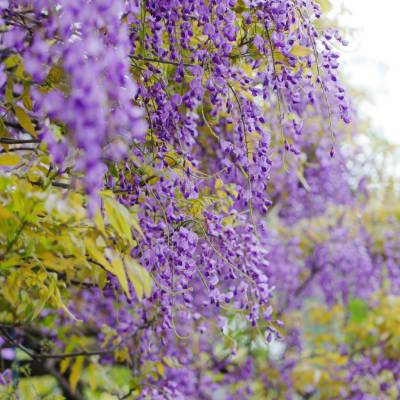
Japanese Wisteria (Wisteria floribunda)
History
The Japanese Wisteria was first brought to the United States in 1830 and was known as a common subject for bonsai design.
Features
The Wisteria floribunda can grow up to 90 feet long with clockwise twisting vines.
It is known as a twinning woody deciduous climber with floral stalks dangling up to an extraordinary 7 feet. Its violet-blue flowering power is perhaps the most dramatic of all the Wisteria genus. Investing in the Japanese Wisteria takes patience as they will only flower after passing through the juvenile and into the mature stage which can take many years.
Care Instructions
This variety of Wisteria does best in USDA Zones 5-9, and planting in the Autumn or Spring will bring the best results. They love full sun and need to be regularly watered, especially in sandy soils. Like all Wisteria, they must be pruned and trained to grow into a lattice or archway.
2. Chinese Wisteria (Wisteria sinensus)
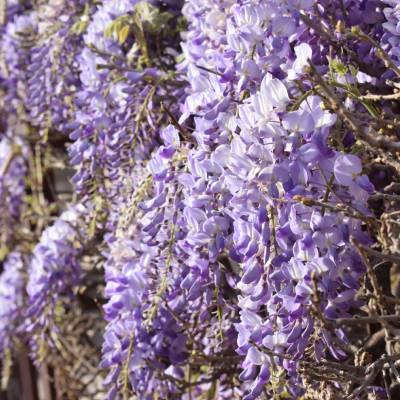
Chinese Wisteria (Wisteria sinensus)
History
The Chinese Wisteria was unknown until 1812, when it was discovered by the East India Company and sent clippings back to England. It was then brought to the United States in 1816 as an ornamental plant. It was coveted for its masses of scented flowers and longevity, living up to 200 years with proper care.
Features
The Wisteria sinensus can grow up to 98 feet long with counter-clockwise twisting vines.
It is known as a twinning woody deciduous climber with aromatic floral stalks dangling up to 6-8 inches in length. Its pale mauve-violet flowers have dark purple tips, and although they don’t have the dangling length of the Japanese Wisteria, they have a distinctive perfume and are considered the higher quality of dangling “racemes”.
The Chinese Wisteria makes a great addition as a front yard centerpiece or scrambling along a garden wall.
Care Instructions
This variety of Wisteria does so well in the United States, that it has become invasive in some areas, likely because the climate is similar to its native China. The Chinese Wisteria does best in USDA Zones 5-9, and planting in the Autumn or Spring will bring the best results.
They love full sun or partial shade, and need to be regularly watered, especially in sandy soils. Like all Wisteria, they will need to be pruned and trained to grow into a lattice or archway.
3. Silky Wisteria (Wisteria brachybotrys)
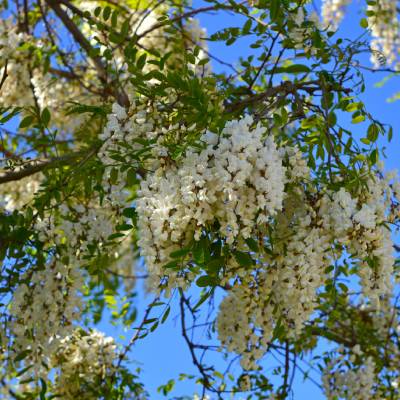
Silky Wisteria (Wisteria brachybotrys)
History
The Silky Wisteria is the lesser known variation of its counterparts and is a relation to the Japanese Wisteria. This variety also thrives in Japan's woods and forests from 100-900 meters and is beloved for its white and pale violet blooms.
Features
The Wisteria brachybotrys bears hairy leaves that can reach 14 inches in length. Its clusters of blooms are reminiscent of grapes and release a fragrant aroma.
It is an anti-clockwise twinning woody deciduous climber with aromatic floral stalks dangling up to 5 inches in length. Up close, the delicate blooms look like pea flowers. Its pale violet flowers have yellow tips and hang amongst felted green seed pods.
Care Instructions
Silky Wisteria is a fast-growing deciduous vine. This variety does best in USDA Zones 5-9, and planting in the Autumn or Spring will bring the best results.
They love full sun or partial shade and need to be regularly watered, especially in sandy soils. They prefer loamy soil types and low nitrogen fertilizer. Like all Wisteria, they must be pruned and trained to grow into a lattice or archway.
4. American Wisteria (Wisteria frutescens)
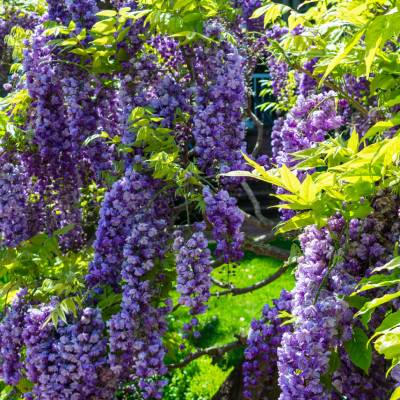
American Wisteria (Wisteria frutescens)
History
The American Wisteria is native to the wet forests and stream banks of the Southeastern United States. It is not an invasive spreader like its Chinese counterpart but thrives in swampy woods, moist thickets, and pond peripheries.
Features
The Wisteria frutescens bears dense clusters of white and bright purple two-lipped flowers. They have the smallest hanging “racemes” of any species, instead appearing more compact than their counterparts.
The American Wisteria is a counter-clockwise twinning woody deciduous climber that can reach up to 50 feet in length. It features unscented clustered blooms dangling up to 4-12 inches in length. Bonsai artists in America employ this variety due to its petite yet manageable flowers.
Overall this variety grows to only ⅔ the size of its Japanese and Chinese counterparts with “racemes” that are half as long. In addition, it has a bloom time of roughly half of those varieties as well.
Care Instructions
American Wisteria is a fast-growing deciduous vine. This variety does best in USDA Zones 5-9, and planting in the Autumn or Spring will bring the best results.
They love full sun or partial shade, but will not fully bloom in partial shade. They prefer moist well drained soil preferring acidic to neutral profiles. Because this variety thrives in wetter areas, it needs to be kept constantly moist to avoid the roots drying out. Like all Wisteria, they will need to be pruned and trained to grow into a lattice or archway.
5. Kentucky Wisteria (Wisteria macrostachya)
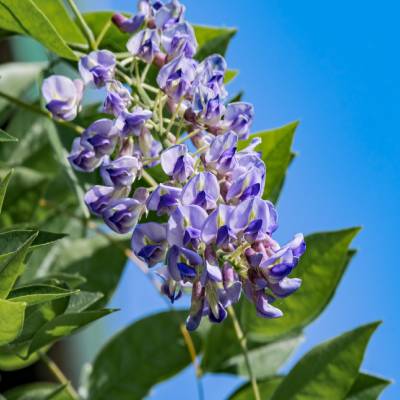
Kentucky Wisteria (Wisteria macrostachya)
The Kentucky Wisteria, also known as the “Blue Moon Wisteria” is native to parts of North America, particularly in the Southeastern United States. They are a subspecies of the American Wisteria and have a few key differences including longer blooms due to its cold hardiness compared to its American Wisteria counterpart.
Features
The Wisteria macrostachya bears dense clusters of pale lavender to lavender-blue blooms. They’re hanging floral “racemes” that can reach 8-12 inches in length making for a spectacular blooming show. Their blooms are typically fragrant and resemble pea flowers when viewed closely.
The Kentucky Wisteria is a counter-clockwise twinning woody deciduous climber that can reach up to 25 feet in length. It is considered the hardiest of all Wisteria and can dependably bloom up to three times in one season.
Overall this variety is similar in size compared to the American Wisteria and considerably smaller than its Japanese and Chinese counterparts.
Care Instructions
The Kentucky Wisteria are a fast-growing deciduous vine. This variety does best in USDA Zones 4-9, and planting in the Autumn or Spring will bring the best results.
They love full sun or partial shade but will have fuller blooms in full sun. Even though Kentucky Wisteria is considered to be drought tolerant, they do best when watered regularly and more so in high heat. They prefer well-drained acidic soil.
Recent Articles

















